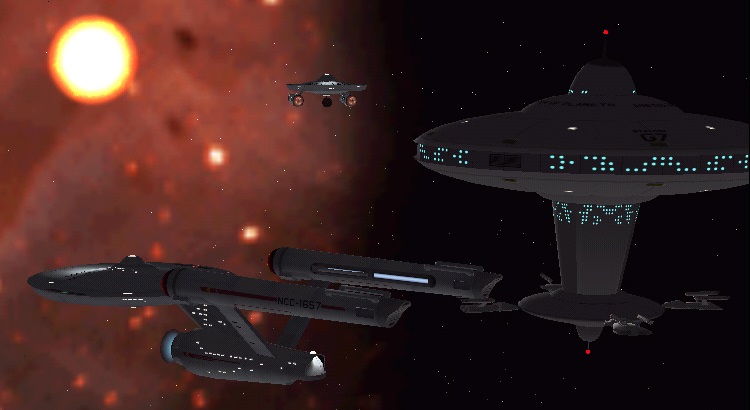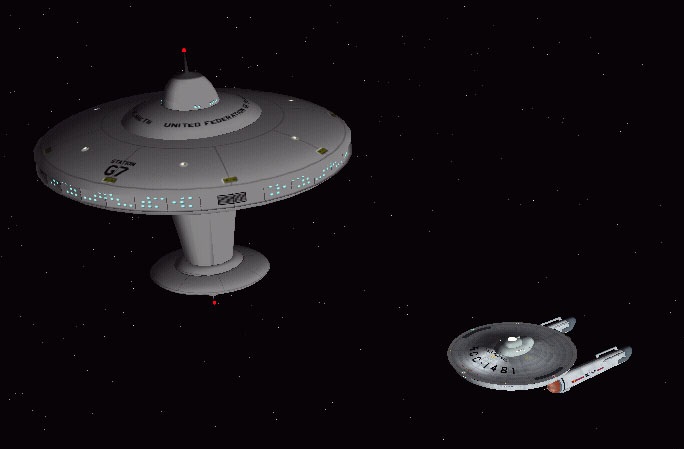| Classification: | Class 2 Orbital Station | ||
| Name: | Space Station G-7 | ||
| Registry Number: | SG7-6118 | ||
| Class: | Gamma ( Greek letter Γ ) | ||
| Type: | Free-floating/orbital frontier outpost with Class 5 docking facilities. | ||
| Commissioned: | 3rd April 2222, Stardate 2222.93 | ||
| Builders: | Starfleet Corps of Engineers |
| Main Disc Diameter: | 325.0 Metres | ||
| Overall Height: | 300.7 Metres | ||
| Central Body Height (without top/bottom sensor spikes: |
262.9 Metres | ||
| Total Mass (including all sections): | 500,000 Metric Tons | ||
| Decks: | 75 | ||
| Crew Capacity: | 500 | ||
| Max. Evacuation Capacity: |
2,000 |
| Officers: | 85 | ||
| Enlisted Personnel: | 415 | ||
| Marines (During war-time): | 500 |
| Type S-10 Travel Pod: | Eight | ||
| Type S-2 Work Bee: | Thirty |
| Type-3/Mark-12B Shuttle: | Four |
| Zodiac-class Warp-Sled Shuttle: | Two |
| Main Power: | One type SW20/1-2SB Matter/Antimatter Reactor rated in total to 256 Cochranes | ||
| Auxiliary Power: | 10 Deuterium/Tritium Fusion Reactors | ||
| Batteries: | 6 Cold Fusion storage cells |
| Sensors: | OC2433C short range, very high resolution sensor suite mounted in a sensor pod located on the upper hull surface at the center of the station "dome". OC3071L very long range, medium resolution sensor suite mounted in a sensor pod located on the upper hull surface at the center of the station "dome". Capable of utilising four independently-operated high-frequency sensor channels simultaneously. |
| Twelve Venusian Agusta Ansadado, Inc. model RIM-6 Class-1 phaser units mounted in twelve banks of one each, located equidistantly around the outer hull surface of the station disc on dorsal and ventral surfaces to provide a 720° firing arc (360° xy + 360° z). | |
| Twelve Terran Asakaze Ordnance Systems Ltd. model RIM-2 Type III defensive phaser units mounted in four banks of three each, located on the outer rim of the disc providing a 720° firing arc (360° xy + 360° z). |
| Six Andorian Skat-Rar Weapons Systems Mk 4 Mod 6 torpedo tubes mounted in six banks of one each giving a maximum spread of six per salvo, located located equidistantly on the outer rim of the disc to provide a 720deg; firing arc (360° xy + 360° z). |
| Personnel (6-person): | 10 | ||
| Evacuation (22-person): | 6 | ||
| Cargo (non-sentient traffic only): | 6 |
| 4 Emitters mounted equidistantly around the outer hull surface of the station disc. |
| Main Computer Core: | Duotronic DIV unit mounted on Deck 20, Central. | ||
| Backup Computer Core: | Duotronic DIV unit mounted on Deck 40, Central. | ||
| Interface System (Standard): | Library Banks Information Retrieval System (LBIRS) v2.3 | ||
| Interface System (Technical): | Dynamic Access Memory Interface Technique (DAMIT) v6.9 | ||
| Data Transfer Rate: | 50 kiloquads/second |
| High Resolution: | 1.2 light years | ||
| Medium to Low Resolution: | 5.3 light years |
| Vessel Maintenance & Repair: | None. | ||
| Defense: | None. |
Space Station G-7 was built in a relatively quiet sector of space behind the protection that Starbases 10 and 23 and the Earth Outposts provided against the Romulan Neutral Zone. Not that such protection was apparently needed at the time of G-7’s construction; it was several sectors from Klingon space and the Romulans had not been seen on over 50 years. As such the sector was as safe as it could be from both of the Federation’s major adversaries.
Also being comfortably distant from the quiescent Romulans, this sector saw a lot of civilian traffic that travelled freely about its space. This in turn however brought in pirates, slavers, and other criminal elements, drawn by the lucrative trade goods, people, and other items of interest passing through. As these undesirables slowly and carefully began to make their presence felt, Starfleet also slowly increased their patrols through the sector hoping to catch them. As this game of interstellar cat and mouse continued to escalate, regularly- and diligently-patrolled trade routes were formed so that Starfleet could better protect the civilian traffic from those preying on it, and pirate activity began to become organised to circumvent these safeguarding measures.
Because of the unchecked nature of the pirate activity despite long-range patrols by high-speed cruisers, Starfleet was finally granted appropriations to build an outpost in the heart of the region most afflicted by pirate activity. This would allow a permanent anti-pirate presence to be established and allow Starfleet to cover the area with far more shorter-ranged patrol craft, which had the knock-on effect of freeing up the cruisers now being used for anti-piracy patrol. This new outpost would be a check-point, to arrest both pirate activity and the flow of contraband goods such as weapons, narcotics, and slaves.

The Constitution-class starship U.S.S. Potemkin visits Space Station G-7 in 2250. |
Over the decades G-7 made its mark, its presence and ships putting an appreciable dent in pirate activity and clamping down on illicit goods traffic in the sector, though most of this was merely pushed into a different, less protected sectors of Federation space. Briefly coming under threat during the Four Years War but never attacked, G7 continued to soldier on and does so to this day.
The re-emergence of the Romulans in 2267 caused much consternation and a change in the base’s operational continue, but with no major threat to the sectors behind the border, life soon settled down into a new routine.
Space Station G-7 was the seventh Gamma-series outpost station to built, in 2222. Its location was selected in part due to increased Klingon adventurism on the Federation border which pushed pirate activity deeper into Federation territory. With Klingon warships abound in the now-“disputed” zones, no pirate wanted to be confronted by a battlecruiser claiming they’d taken its prize. Operations were moved to the more lucrative and previously safer space between the Federation Core Sectors and the Romulan border sectors. With Starfleet’s interior patrols being thinned down to confront the increasingly belligerent Klingons, formerly inaccessible trade routes began to appear ripe for the picking.
Picked they were, too, and quite extensively before Starfleet conceded they had to re-deploy to meet this new danger to their civilian shipping and interior colonies. More ships arrived; at first older vessels of 22nd-Century vintage, it was soon realised that these vessels were outmatched by the more modern vessels used by pirates and the Penzance Cartel’s organisation of intelligence-based hit-and-run raiding. To combat this, more capable and modern vessels began to appear.
To support the growing anti-pirate operations in the sector, authorisation to construct a new outpost was given. It was decided that a full-sized fleet command base was unnecessary at the current operational tempo and threat level. What was needed was merely a resupply and minor repairs depot, administration and fleet co-ordination centre for merchant shipping, civilian vessels, and their Starfleet protectors, and a marshalling point for convoys and their escorts.

The Mikasa-class frigate U.S.S. Kusanagi holding position beside Station G-7. |
The new Gamma class of outpost station fit this bill well. With plenty of shuttle berths for its Class-F and Class-G small craft and entertainments galore for passing crews, G-7 was essentially a “truck stop” in space for weary long-distance haulers and their local protectors alike.
Station G-7 became an anchor point for trade routes and space lanes in its sector and still does a brisk business all year around, with commodities from scores of worlds in surrounding sectors making their way to the stores of G-7 commercial section. Because of this, G7 became an even more popular stop, this time for souvenir-hunters and those out for a unique gift for someone special.
Station G-7 plays host to a number of smaller Starfleet ship classes, though over the years decades these designs have moved with the times. At first home to a half-dozen Kiaga and Agilis-class perimeter action ships, another half dozen older FF200-class frigates, and the occasional Kovaris-class destroyer, G-7 now boasts Mikasa-class frigates, a couple of Surya-class heavy frigates, a Saladin-class destroyer, and a Coventry-class light cruiser, while still maintaining the rapidly aging Kiaga and Agilis classes, for whom no replacement is forthcoming as the proposed Akyazi class is held up in endless debates on their necessity, or at least the necessity of over one hundred of them.